Stall torque is the maximum torque that the unit can supply when in 'locked shaft' condition. This doesn't mean you actually have to mechanically bolt the shaft or anything, it just means the torque that can be dished out from a dead stop.
Applying a torque that opposed motion, that is less than the stall torque, will cause the rotational speed to slow down and the unit will draw more current. Applying an opposing torque that is greater than the stall torque will overcome the unit's abilities and will drive it backwards.
The value of 0.8 kg-cm means the amount torque you would get if you were to bolt a 1cm long arm to the shaft (set and right angles to the axis of rotation, and positioned dead horizontal), and hang an 0.8kg mass at the end of the arm. This is a product, so it's also the amount of torque you'd get using 0.08kg (i.e., 80g) at the end of a 10cm shaft, etc.
FWIW, the proper SI unit for torque is newton-meters, or possibly even newton-centimeters would be acceptable, as torque is defined as FORCE (Newtons) x MOMENT-ARM (distance). The english units are lbf-ft, pounds-force * feet, often written just ft-lbs, and this probably has influenced the less rigorous spec sheet writers to cast their 'metric' torques in the somewhat mistaken units of kg-cm, kg-m, and g-m.
